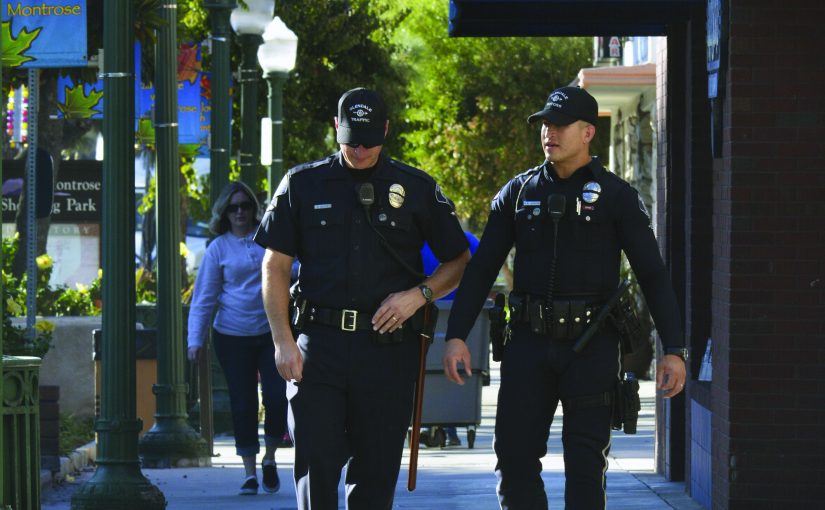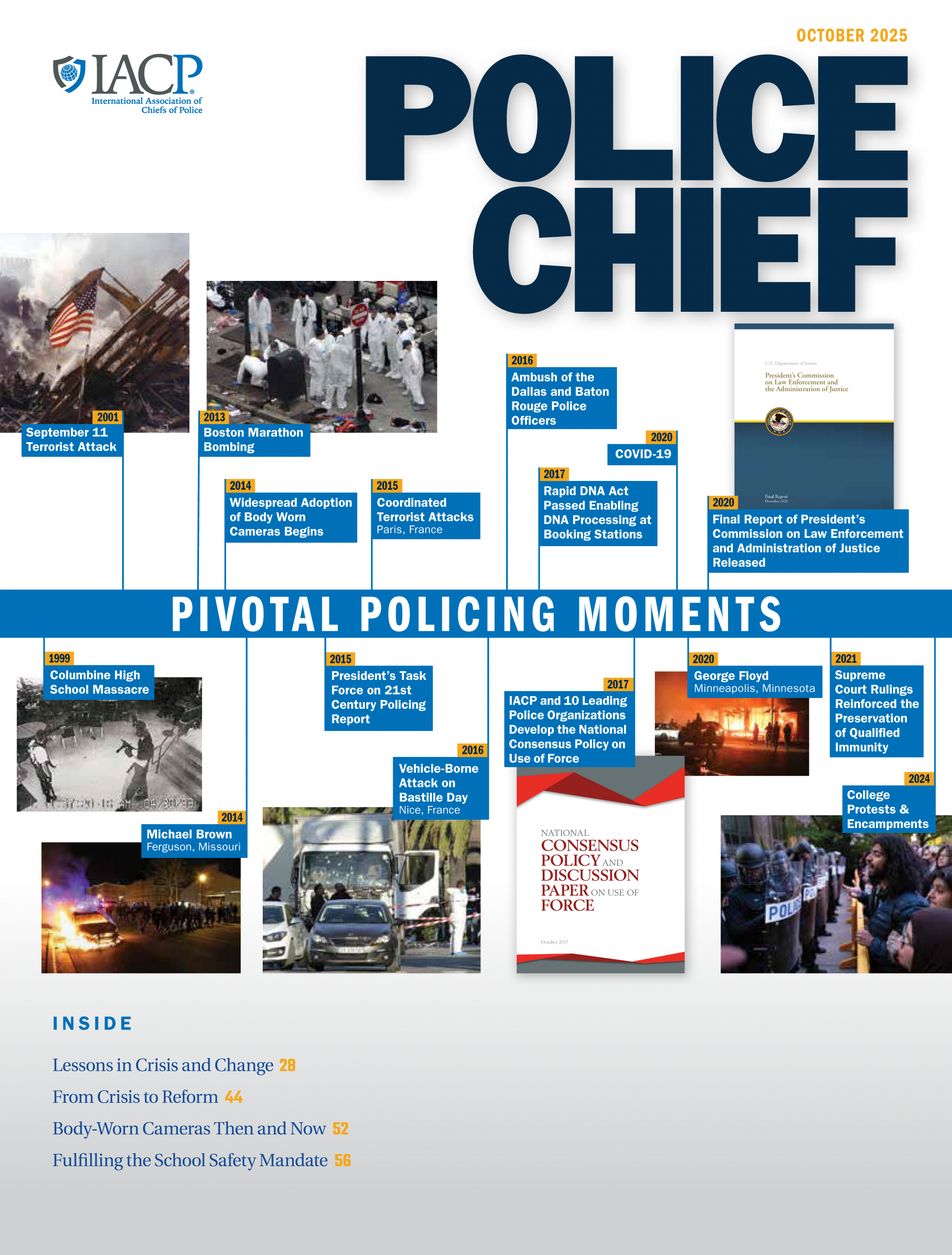Law enforcement agencies worldwide are redefining officer wellness; recognizing that a healthier person makes a more relaxed, centered, and fulfilled officer, agencies are providing their law enforcement staff with an increasing amount of support. The Cedar Park, Texas, Police Department (CPPD) embraces officer wellness to an exceptional degree and developed the following program to ensure that CPPD’s officers are more than superficially healthy. The program’s benefits are compelling, and the program’s structure and guidelines are universally applicable. Other law enforcement leaders could reap similar benefits by implementing such a program in their departments.
Chief Sean Mannix is a man on a mission. The police chief of the Cedar Park, Texas, Police Department thinks more needs to be done in the area of officer wellness. And not just more of the same. It’s time to go deeper. Wellness is critical to officer safety, says the chief, and is the key ingredient in fostering happy home lives for people in high-stress jobs. And, for law enforcement, these are high-stress times, perhaps higher than usual.
Chief Mannix wants to lead the charge into a new era of wellness for law enforcement that does more than just scratch the surface. To that end, he and his department have spent the past six months putting together CPPD’s model of law enforcement wellness.
According to Mannix,
We can train people all day long on how to interact with others but if we ignore training our folks to get in touch with themselves, understand why they do what they do, and be able to make the adjustments that are appropriate in their own lives, then we’re only partially training them. What it comes down to is you build better officers by building better people.1
The department’s cutting-edge program consists of three main components aimed at developing officers from the inside out: physical readiness, mental and emotional wellness, and spiritual and psychological well-being.
1. Physical Readiness
The first component in CPPD’s wellness program addresses the physical. Like most police departments, CPPD begins with fairly standard physical requirements including obstacle course and rowing machine tests that have been validated for physical abilities assessment. But that’s just the tip of the iceberg.
CPPD has a cardiologist on board, who is also a reserve officer, overseeing some of the most innovative testing available. With a background in medicine, military, and policing, he understands that obesity, diabetes, hypertension, and coronary heart disease are among the top threats facing police officers. Interestingly, research is finding heart disease in about 55 percent of asymptomatic officers between 35 and 50 years old irrespective of weight.2
Because coronary heart disease is the number one killer of law enforcement officers—officers are 24 times more likely to suffer a ‘cardiac event’ than get shot or stabbed by a suspect3—the department makes available CT scans and blood tests that can detect even the smallest flecks of calcium and inflammation of the blood vessels that can indicate early stages of blockage. This means officers can understand their cardiac condition long before blockages develop or cardiac events occur.
The testing is voluntary and is typically taken by officers over 35 years old. Going beyond the typical, the cardiologist has set up a foundation to help officers pay for the screening, which, in the end, makes testing more affordable.
The physical readiness component also includes a diet and nutrition program. Not simply an eat right and exercise element, this aspect of physical wellness uses DNA profiling to collect a massive amount of data and create a customized report outlining the best nutritional approach for each individual. A clinical nurse specialist (and dietician) goes over the report with each officer to create a program for good eating habits. Diet and exercise, stress reduction techniques, medication, and supplements can stop the progression of heart disease and even regress it.
The last part of physical readiness is life-saving training. Every sworn officer is trained in traumatic (tactical) combat casualty care adapted for law enforcement. The department provides each officer with a standardized Individual First Aid Kit (IFAK) and belt-mounted tourniquet.
2. Mental and Emotional Wellness
Another innovative area in the CPPD wellness program is the mental and emotional well-being component. The department goes beyond standard stress management and general communication classes to help officers both at work and at home on a deeper level. Complementing the mental and emotional wellness block of personal leadership classes, standard law enforcement leadership classes are also offered.
The first class in the series, which is mandatory for all sworn officers, is Understanding Fear and Improving Emotional Intelligence. Rather than focusing on the dangers on the street, the fear class helps officers understand how their own personal fears are influencing their communication style, decision making, customer service, and general attitude toward the public, their colleagues, and their family members. Fear is a main driver of stress, anxiety, frustration, manipulation, uncontrolled temper, and a host of other cognitive and behavioral responses.
An unlikely connection among fear, emotional intelligence, and daily life is seen in the Time Management and Organizational Skills class. Like most other people, officers frequently self-sabotage, failing to identify priorities and act on them. Issues such as procrastination, perfectionism, and disorganization waste time and are driven in large part by fear.
The Positive Interaction with Difficult People class teaches more than just understanding how to deal with another person. Officers learn how their own communication style grows directly out of their own fear. According to Chief Mannix,
When a cop meets anger with anger, that’s a bad formula. But well-rounded officers aren’t going to get angry just because a citizen talks back. Those officers are in control of themselves and will be able to talk somebody into handcuffs. They aren’t going to have to fight that fight.4
The Customer Service class brings a different perspective to an age-old problem. The focus is not on that tired and worn adage—the customer is always right. That is far from true in issues facing law enforcement. This class is primarily about officers and their ability to accurately interpret the situation at hand and appropriately respond using the tools taught in the class.
An area of officers’ lives that departments frequently ignore is their financial health. The Managing Personal Finances class explores money mind-sets and fundamentals of managing personal finances. This class is combined with a blueprint on how to retire well from law enforcement, delivered by a certified retirement planning consultant who has worked specifically with police retirement issues. Being in sound financial shape helps reduce stress, anxiety, tension, and frustration both at work and at home.
An important component of CPPD’s program is extending the wellness classes to 911 telecommunicators. This high-stress position sees dramatic turnover in many jurisdictions across the United States, with budget dollars being spent on replacing burnt out dispatchers rather than providing wellness training at the beginning of careers.5 CPPD is providing wellness training to dispatchers within months of coming on board.
3. Spiritual and Psychological Well-Being
CPPD maintains a strong chaplaincy program to help officers get through difficult times. “Things don’t always go right on the streets, and we want our officers to have access to support after traumatic events. We also just want them to have a place to go if they need to talk,” says Chief Mannix.6
The department has six chaplains who handle the emotional challenges that law enforcement officers frequently face. The philosophy of the chaplaincy program is based on creating a safe and secure environment in which officers can “let the trauma out of their hearts,” as the lead chaplain says.7
The chaplaincy provides a way for officers to let go without judgment.
One thing officers need to understand is that tears are not weakness. You better learn to cry in life. It releases toxins in your body. Officers are so stoic. They don’t trust anybody and they don’t want to show their feelings much. It’s ok to hug and show a little affection here. Don’t be so stoic.8
The chaplaincy program, along with the other components of the wellness program, is designed to give officers the opportunity to increase self-awareness and not be so hard on themselves and those around them. “It’s all about relationships,” says the lead chaplain. “There’s an old proverb that says, ‘If you want to run fast, run alone. If you want to run far, run together.’” Running together means understanding self and then others to create more successful relationships. “Our chief is on target with this wellness program.”9
The spiritual program is complemented by standard psychological counseling services available through the department’s Employee Assistance Program.
One major point driven home to the officers at Cedar Park PD in all aspects of the wellness program is that everything is connected. Health, nutrition, weight, finances, communication skills, performance on the street, attitude at home, time management, retirement, and all other aspects of life are interconnected. They all make up personal and professional wellness. This is what Chief Mannix is striving for.
I recognize that the public sentiment of policing is cyclical, it ebbs and flows. The challenges always lead to improvements. What we’re doing here is very much at the forefront of what other departments around the country are going to be doing.10
Notes:
1 Sean Mannix (Police Chief, Cedar Park, Texas, Police Department), interview by author, January 21, 2016.
2 Jon Sheinberg, MD, (Lieutenant, Cedar Park, Texas, Police Department), telephone interview with author, February 5, 2016.
3 Jon Sheinberg, MD, (Lieutenant, Cedar Park, Texas, Police Department) telephone interview with author, February 5, 2016.
4 Sean Mannix (Police Chief, Cedar Park, Texas, Police Department), interview by author, January 21, 2016.
5 Adam Timm, (President, The Healthy Dispatcher), interview by author, July 29, 2016.
6 Sean Mannix (Police Chief, Cedar Park, Texas, Police Department), interview by author, January 21, 2016.
7 Roger Wilson (Senior Chaplain (ret.), Cedar Park, Texas, Police Department), telephone interview by author, February 20, 2016.
8 Roger Wilson (Senior Chaplain (ret.), Cedar Park, Texas, Police Department), interview by author, February 20, 2016.
9 Roger Wilson (Senior Chaplain (ret.), Cedar Park, Texas, Police Department), interview by author, February 20, 2016.
10 Sean Mannix (Police Chief, Cedar Park, Texas, Police Department), interview by author, January 21, 2016.



